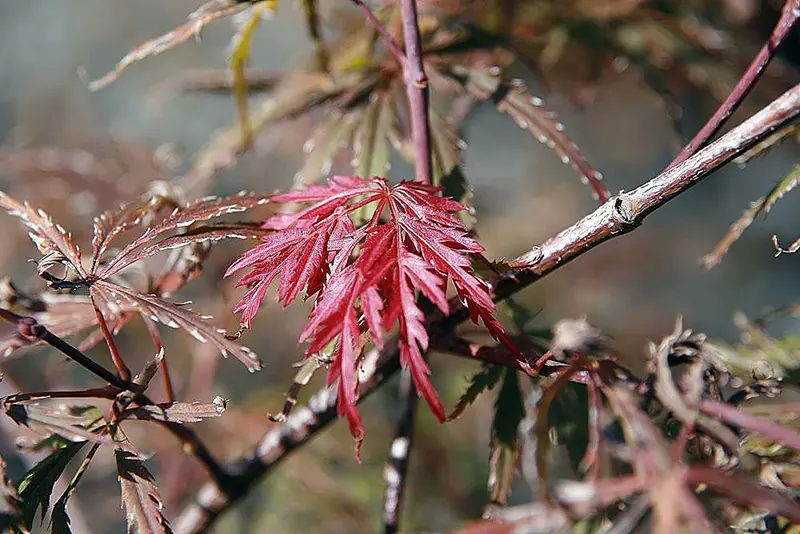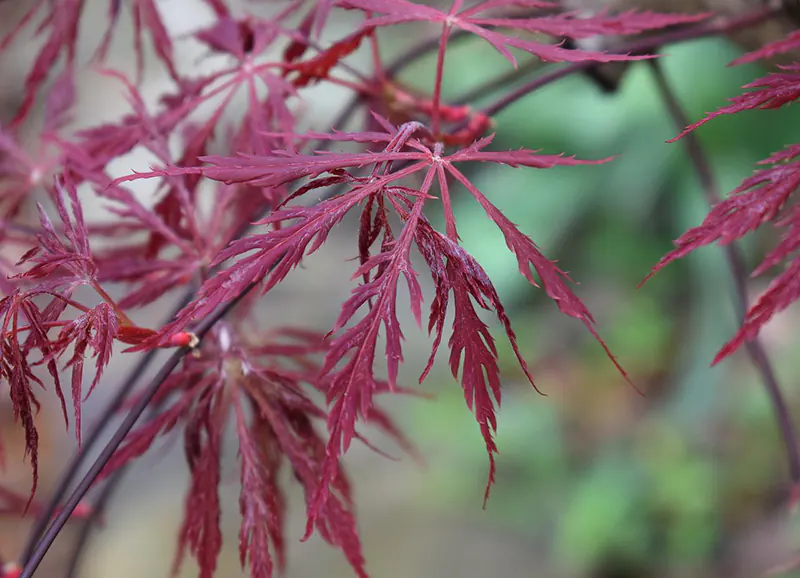Garnet Japanese Maple | Bonsai Care Guide
Acer palmatum var. dissectum
The garnet Japanese maple is a beautiful tree in your garden or as a bonsai. The tree has gorgeous leaves that often show a reddish-purple shade. As a bonsai, the Garnet maple is easy to care for but will command a fair bit of attention if you choose to grow it.
We’ll explain all the details you need to know about the garnet Japanese maple through this article. We explain everything you need, from the benefits of akadama mix soil to why you should prune the tree during the autumn months.
Here's what you'll find in our Garnet Japanese Maple bonsai species guide:
Here's what you'll find in our Garnet Japanese Maple bonsai species guide:
01
02
03
04
05
Quick Garnet Japanese Maple Bonsai Care Sheet
If you only want a quick overview, this small table will get you started on the basics of caring for the garnet Japanese maple.
Recommended soil | Akadama mix with lava rocks and pumice is the best option. A well draining soil works well as an alternative. |
Watering | Water at least once a day, if not more frequently. |
Potting season | Repot every second year, preferable during the growing seasons. |
Shaping and pruning season | Smaller leaves are prunable throughout the year. Large branches should be cut off during autumn. |
Light | Requires plenty of sunlight each day. Summer afternoon sun can damage your tree. |
Fertilizing | Solid organic fertilizer. Mix with liquid fertilizer once a week for a stronger option. |
Propagation methods | Seeds, cuttings, and air layering. |
Pests and diseases | Aphids and fungal infections such as verticillium wilt. |

How to Care for a Garnet Japanese Maple Bonsai
In this section, we’ll explain all the details you need to know to take care of your garnet maple bonsai. We’ll explain watering frequency, how to repot your tree every second year, and everything else.
Best Soil
Any bonsai soil that drains well is a great choice for your garnet maple bonsai. However, this pick isn’t the best option available. If you’re willing to spend a little more, getting an akadama mix that has lava rocks and pumice mixed in will do wonders for your tree.
This soil mixture has improved moisture retention thanks to the stones mixed into it. Having better water retention while still draining fast enough will lessen the frequency you need to water this bonsai.
Watering
As an extremely thirsty species, the Japanese maple will require your attention at least once a day. The garnet maple needs to be watered once a day, if not more frequently, during warmer weather and longer sunlight exposure.
Always touch your finger to the soil before watering. This process will tell you how wet the soil is and if you should wait until later or tomorrow to water the bonsai again.
Repotting
With a fast-growing root system, the garnet Japanese maple needs to be repotted every second year for its health. If this process is avoided, the roots will continue growing within a confined space and eventually cause damage to your tree’s health.
When repotting, it’s best to use a pencil or similar item to untangle the roots. Once untangled, you’re more easily able to prune the roots. Ensure each cut is precise and clean, lessening the risk of a fungal infection. Additionally, wash your container thoroughly before planting the bonsai back into it.
Shaping and Pruning
Most of the tree can be trimmed at any time of the year. These prunable pieces are the small shoots, twigs, and leaves growing on your tree. However, you can’t prune the larger branches freely without placing stress on your garnet bonsai. You should only cut these stronger limbs during autumn.
For the best outcome, use cut paste on larger branches after pruning. Additionally, the smaller trimming should only be done once every second year, limiting the stress on your tree. Pruning the leaves will help newer, more delicate leaves to grow.
Location and Sunlight
Requiring plenty of sunlight, the garnet Japanese maple can handle direct and indirect sunlight. The only sun that may cause damage to your tree is the afternoon sunlight during the summer, which will affect your tree’s leaves. Ensure the tree receives at least five hours of sunlight each day.
The bonsai thrives when the environment is well-aired but not in extreme winds. If kept in a partially shady area, maneuver the tree to receive morning sun if it will be in any direct sunlight.
Fertilizing
An organic solid fertilizer is the best option for the garnet Japanese maple. The fertilizer is slow-acting, gradually releasing nutrients each time you water your tree, which may be more frequent than once a day. This fertilizer may need replacement more commonly than expected, depending on your tree’s thirst.
If you need a stronger fertilizer, and it won’t negatively affect the tree, mix in a liquid fertilizer with your water once a week. Ensure that neither solid nor liquid options are high in nitrogen, which will rapidly grow your bonsai’s foliage.
Propagation Methods
Seeds, cuttings, and air layering are all viable methods of propagating your Japanese garnet maple. However, for the best results while propagating this tree, begin the process during early autumn. While they may grow during any stage of the year, air layering or using cuttings will place the least amount of stress on your tree during this season.
Pests and Diseases
Of diseases, verticillium wilt is one of the most common and lethal infections your garnet Japanese maple can suffer from. This infection is deadly and can kill your tree if left to spread. Fortunately, trimming the infected area and providing plenty of nutrients to your bonsai can help it pull through.
Pests are annoying, especially aphids which commonly feed on your garnet bonsai’s sap. There is, thankfully, an easy method to keep them away. Misting your tree regularly will deter these pests, and if an infestation occurs, you can purchase a normal insecticide.
Considerations for Growing an Indoor Garnet Japanese Maple
Growing the garnet Japanese maple indoors requires a bit of careful preparation. Placement and fungal infections are two things you’ll need to pay close attention to. The area you keep the tree will affect its growth.
Placement
If you’re moving the garnet Japanese maple indoors, you’ll want a location near a sun-facing window. The morning sun is best for your bonsai, as the afternoon summer sun can damage your tree in severe cases but will affect the coloring of your leaves. Additionally, it’s important that the tree is in a well-aired environment.
Common Issues When Caring For a Garnet Japanese Maple Bonsai
With any bonsai, you’ll encounter some problems more than others. Here are the two most likely issues you’ll face when growing the garnet Japanese maple.
Pests
Aphids are a fairly common annoyance when growing bonsai. You can keep these tiny sap-eaters away from your tree by frequently misting the bonsai with water. However, if they keep coming and cause an infestation, most regular insecticide works well without any lasting effect on your garnet Japanese maple.
Watering
With the garnet Japanese maple, watering frequency is one of the most frequent and lethal issues you’ll run into. The tree is extremely thirsty, often needing water more than once a day to grow properly. However, if you begin to water it out of habit, two or three times a day, you’re likely to overwater and harm the bonsai.
Using the soil-touch method is a great way to recognize when the tree needs more water consciously.
FAQs about Garnet Japanese Maple Bonsai
If you’re looking for a quick answer, here are four of the most commonly asked questions. We explain the growth rate and total height of the garnet Maple tree and details about the Japanese maple species as a whole.
The garnet Japanese maple is a great tree that grows well, growing 3-4 inches per year. This tree also holds its reddish coloring during the warm summer weather.
Japanese maple trees are excellent bonsai material as they’re small and take well to most environments. The bonsai will require a lot of attention as it often needs watering and plenty of sunlight. However, this species is one of the prettiest you can grow due to its reddish leaf coloring.
When grown in your garden, the garnet Japanese maple tree can reach a height of six to eight feet. The tree grows at a rate of four inches per year, requiring many years before it stops climbing upwards. As a bonsai, you’ll likely have a smaller tree than many other species.
The Japanese maple species is great for bonsai as it can be grown both indoors and outdoors. The tree will require a sun-facing window that you can open, as an aired environment helps it grow. Additionally, you’ll want to have the tree in an easily accessible location due to its thirst.







